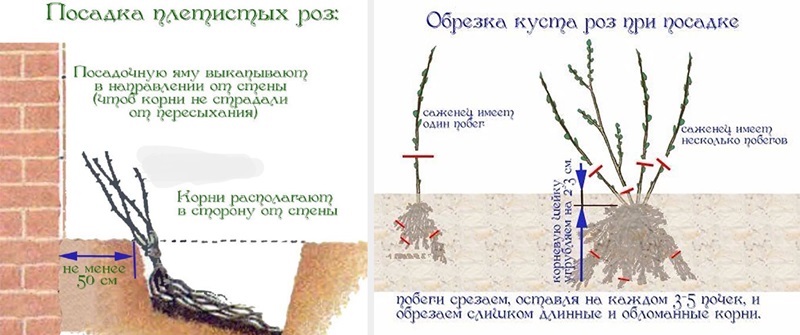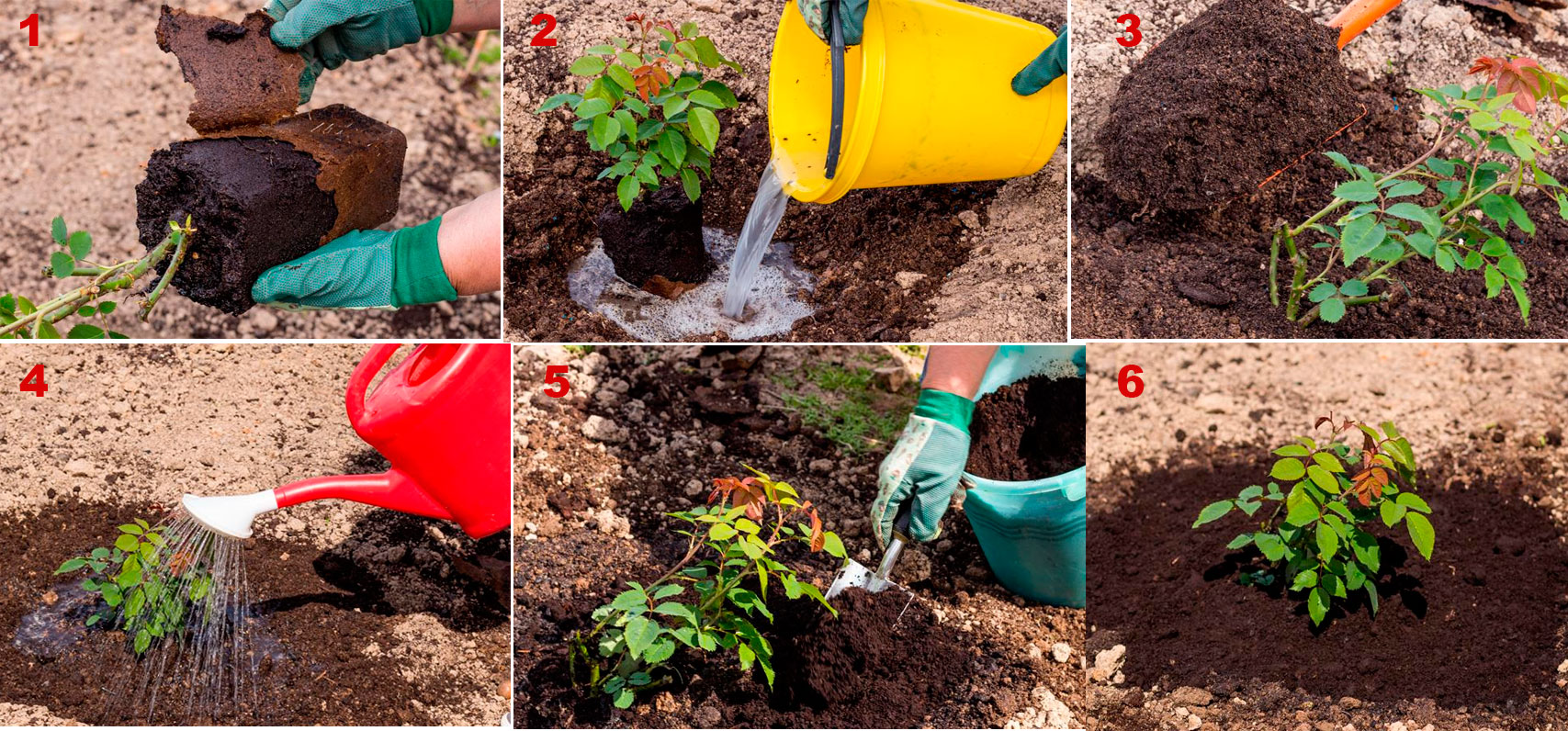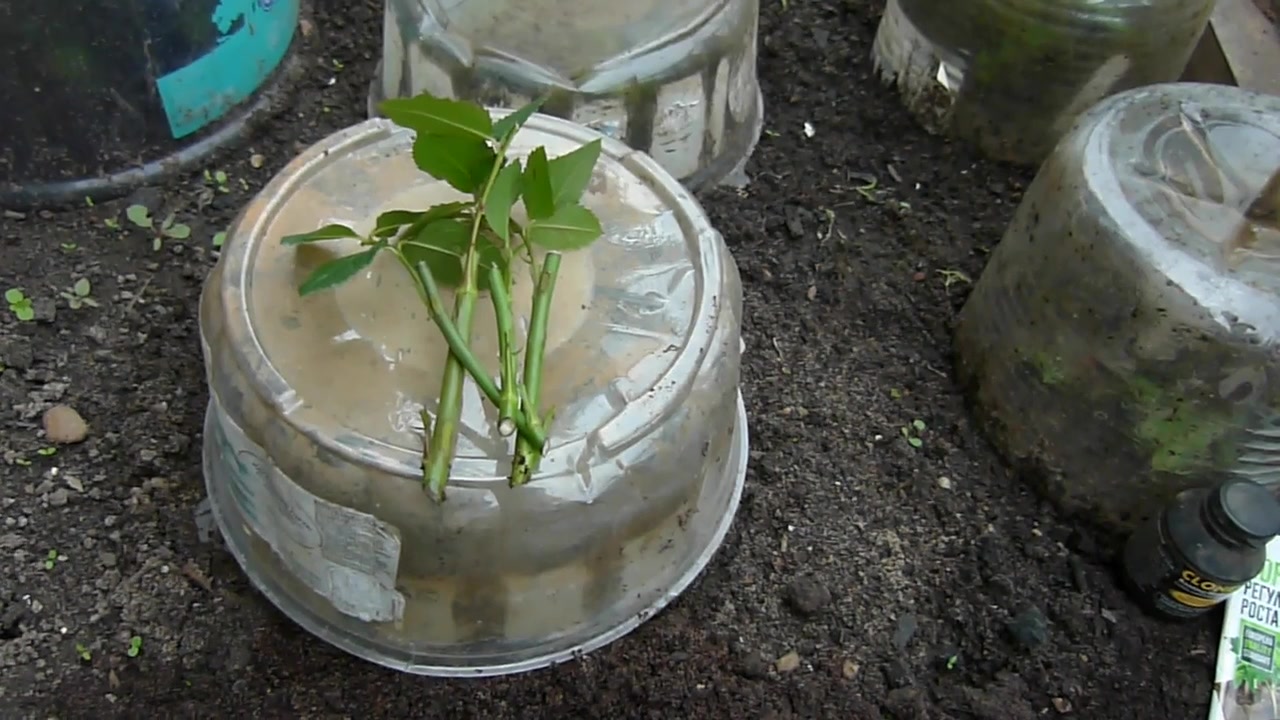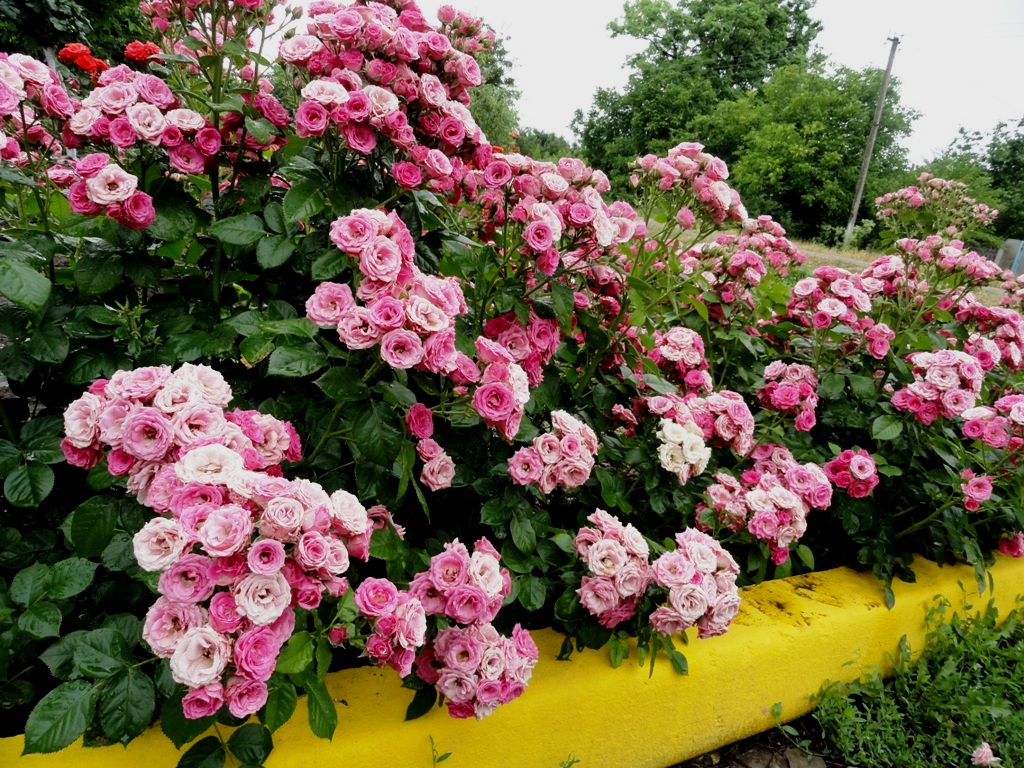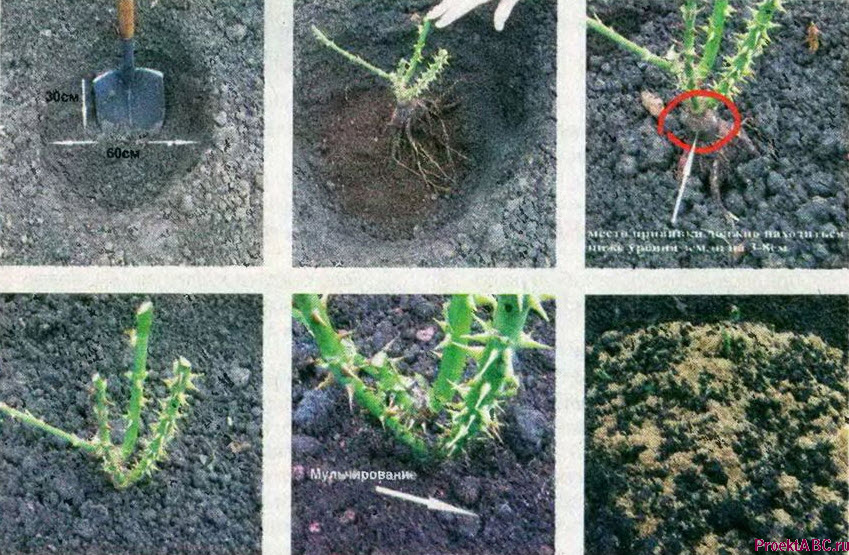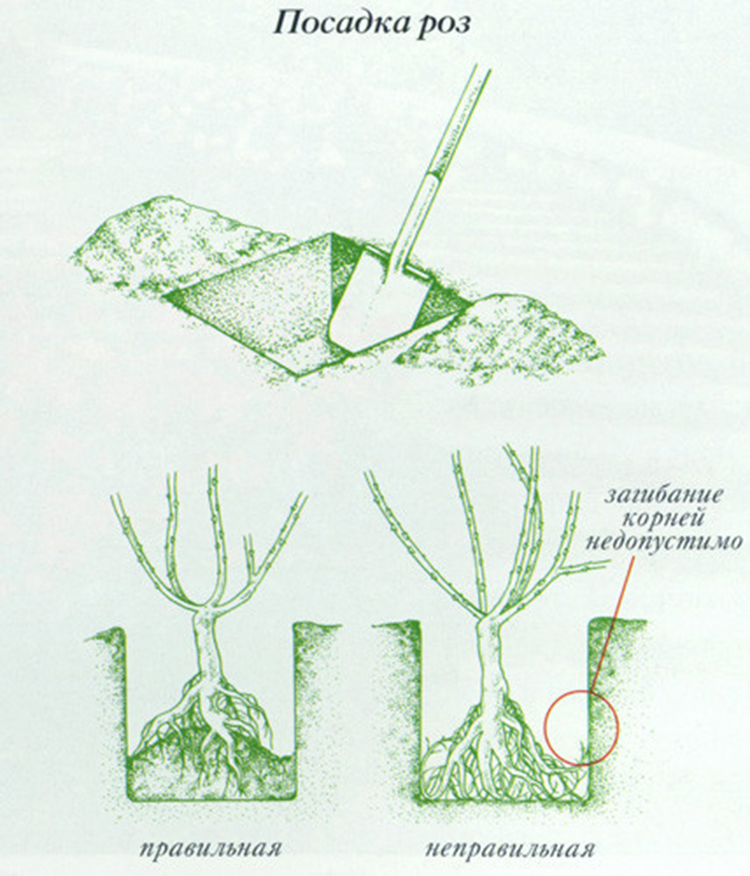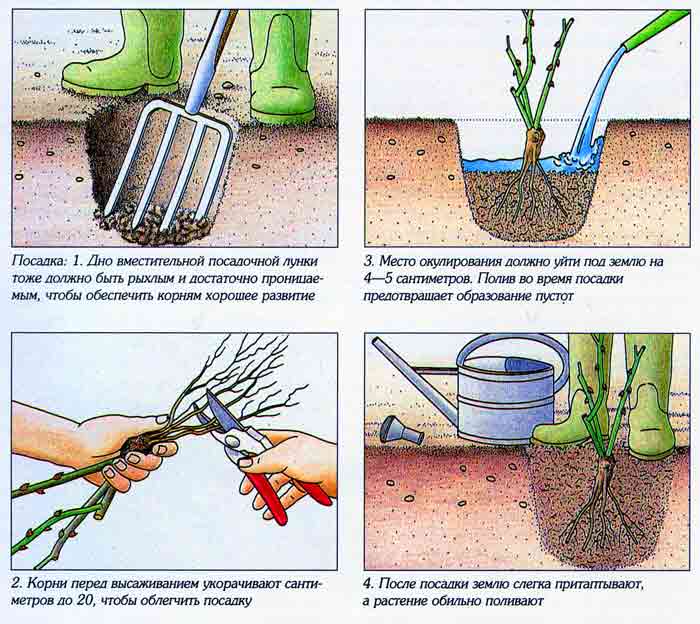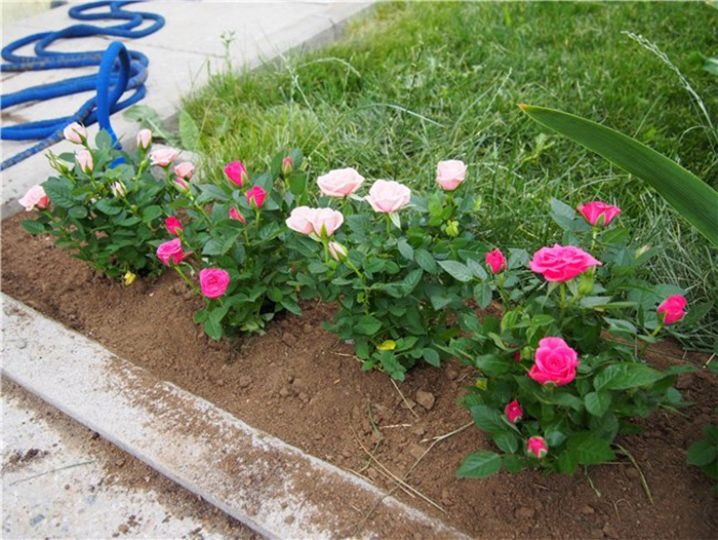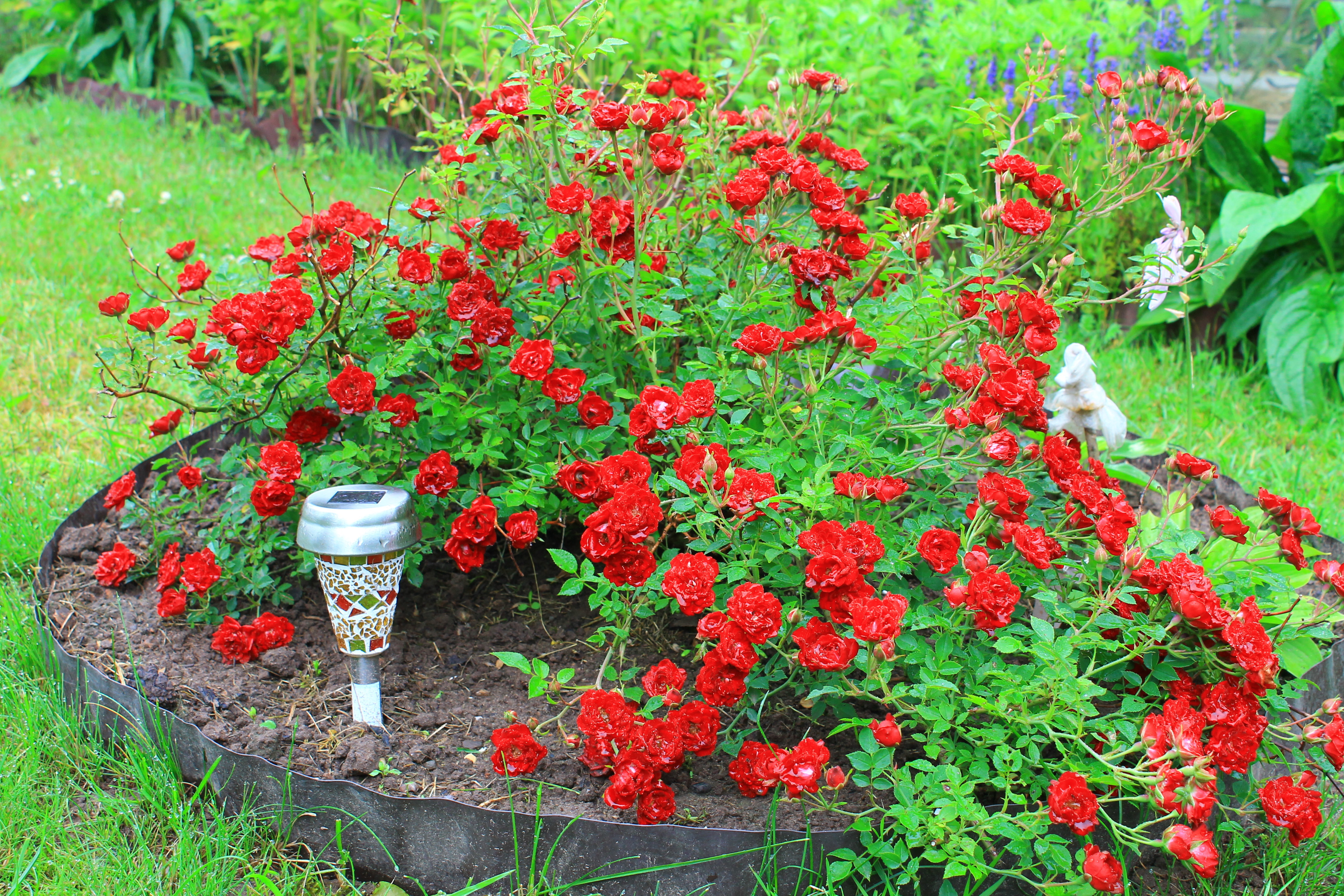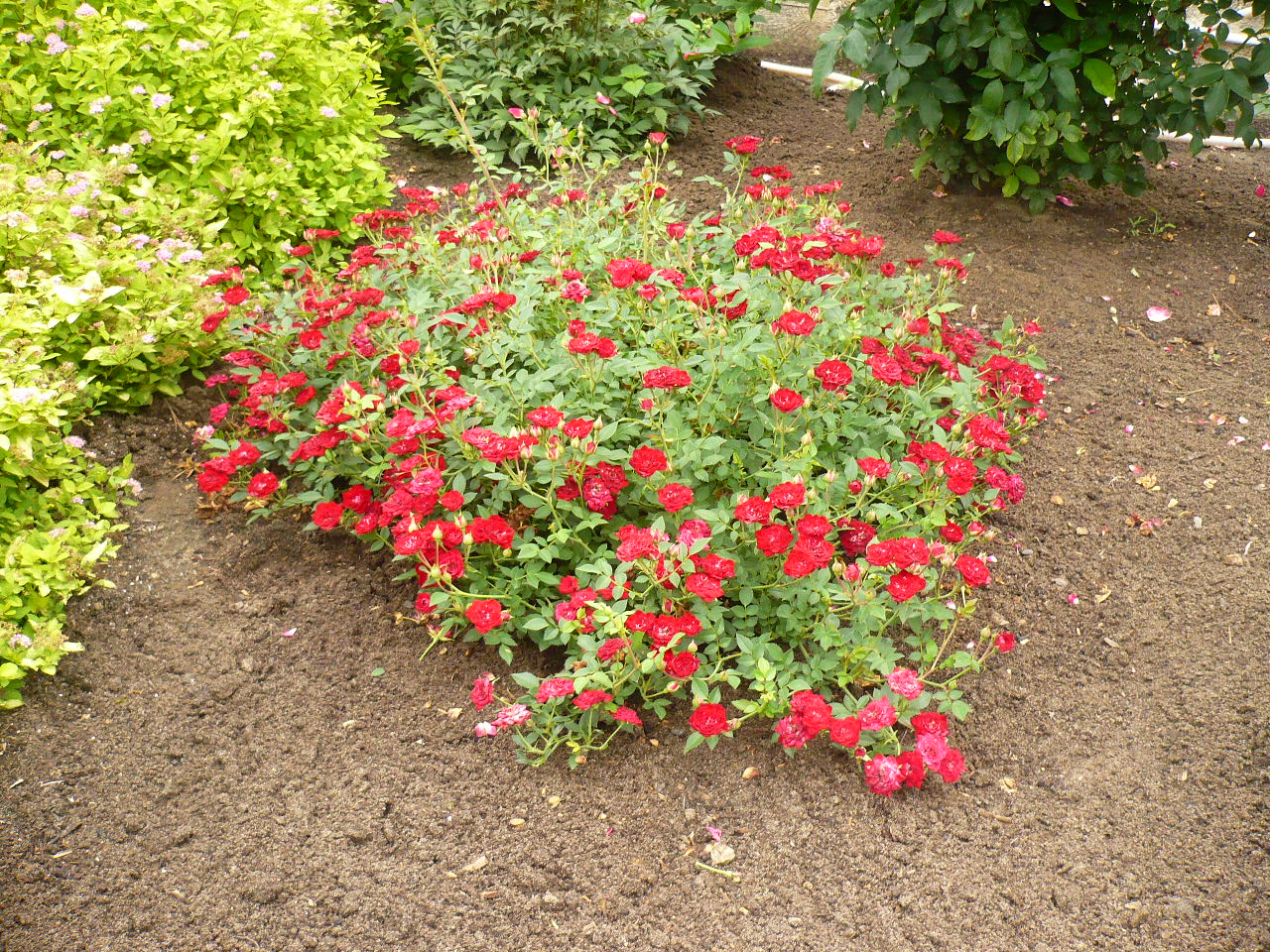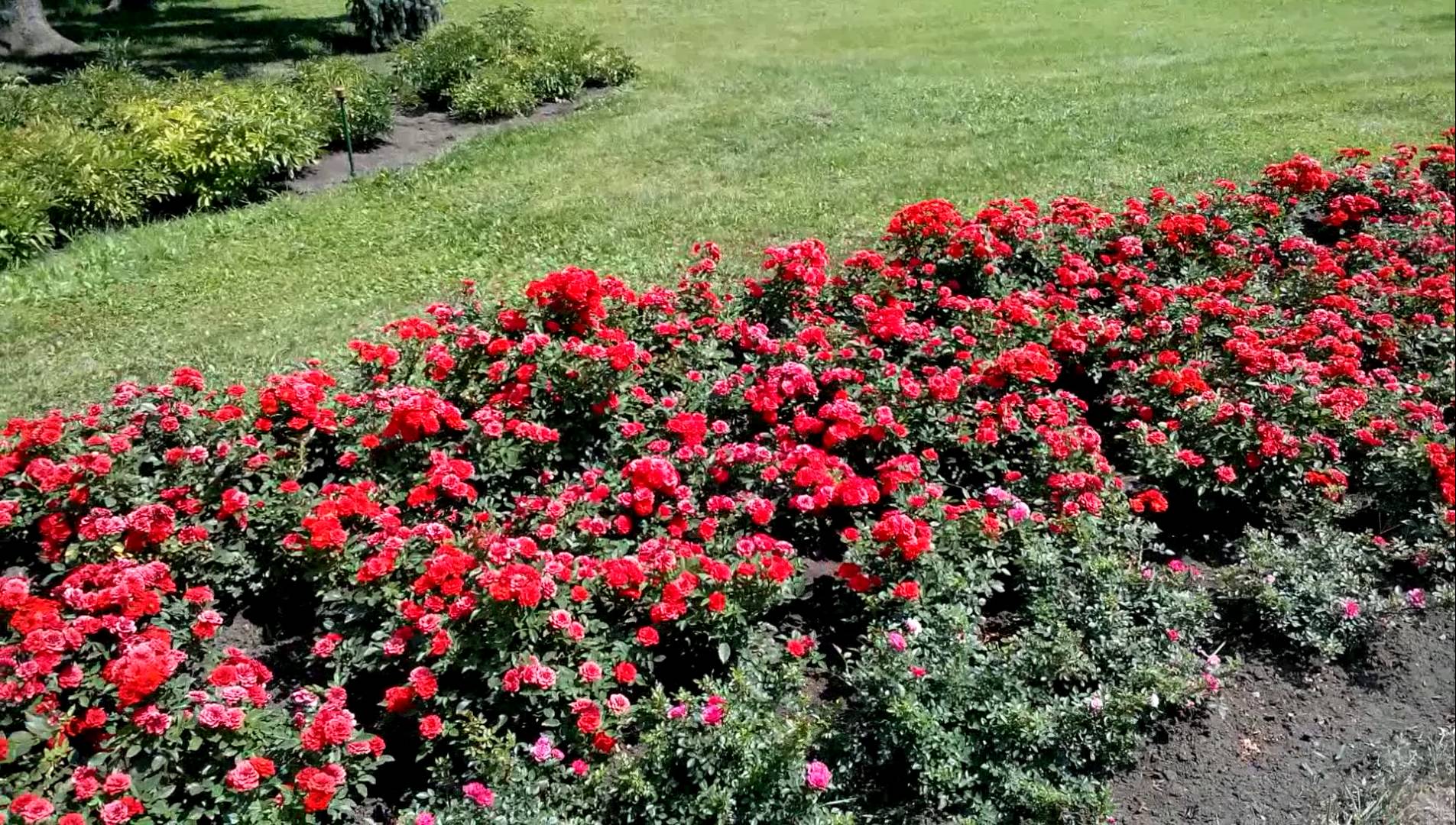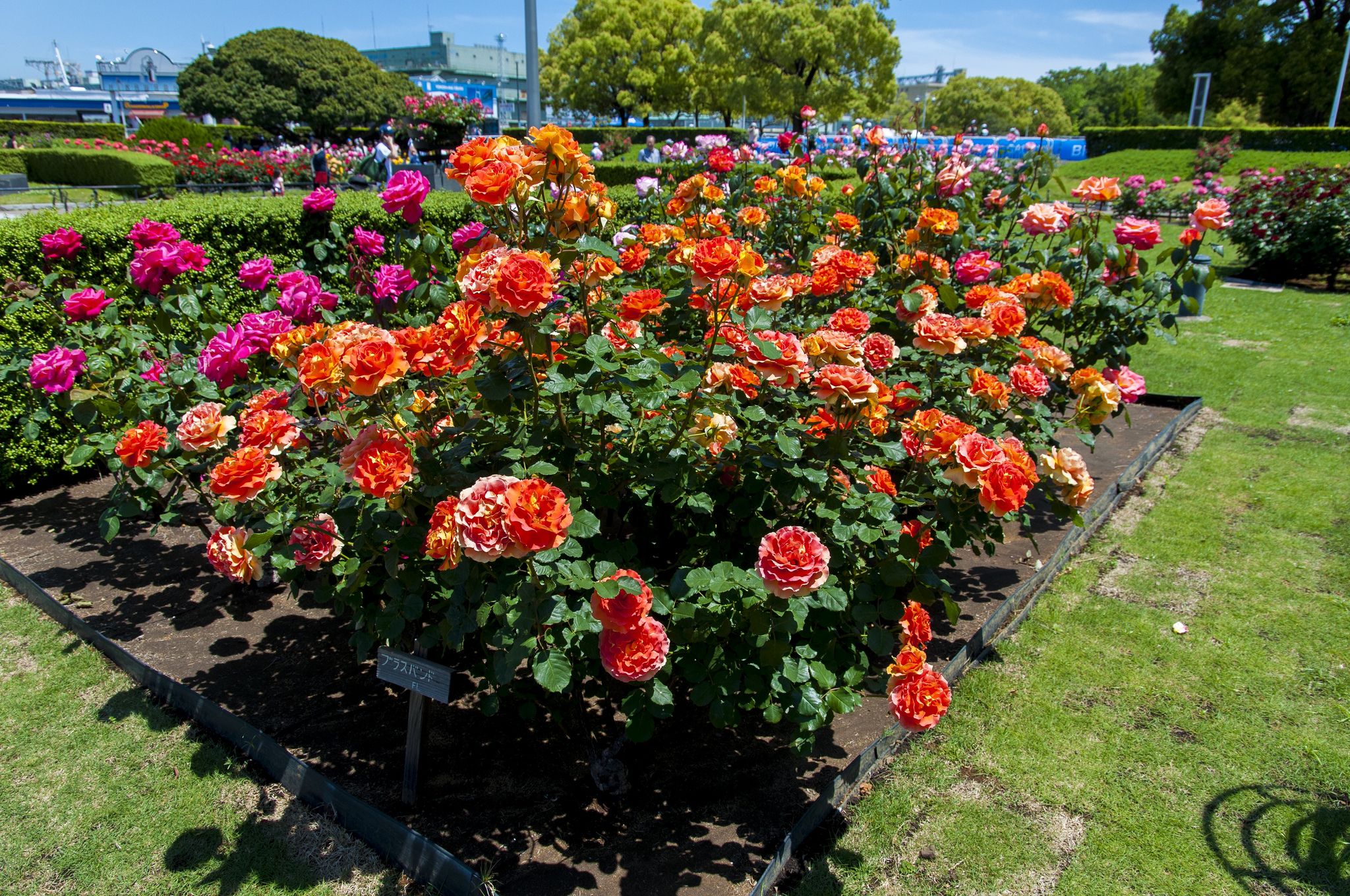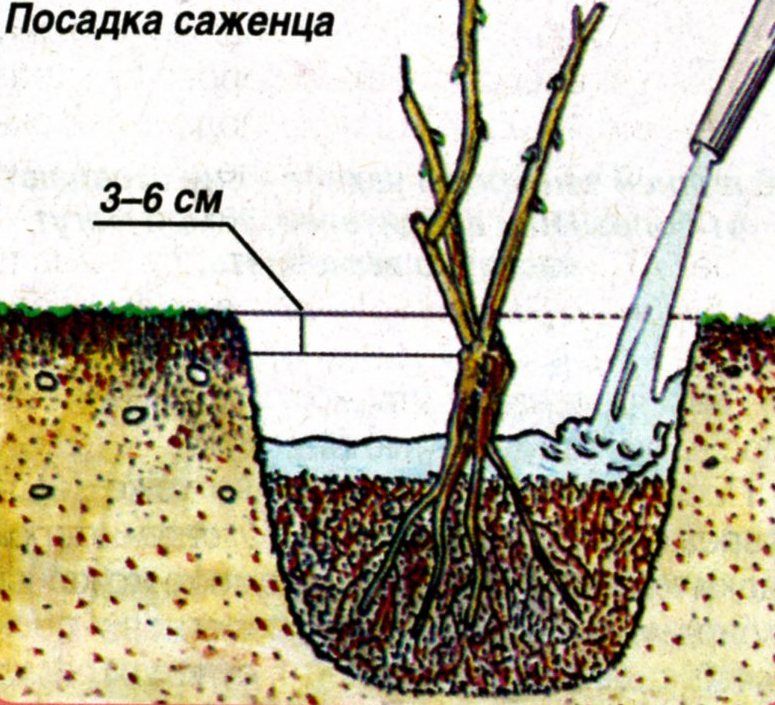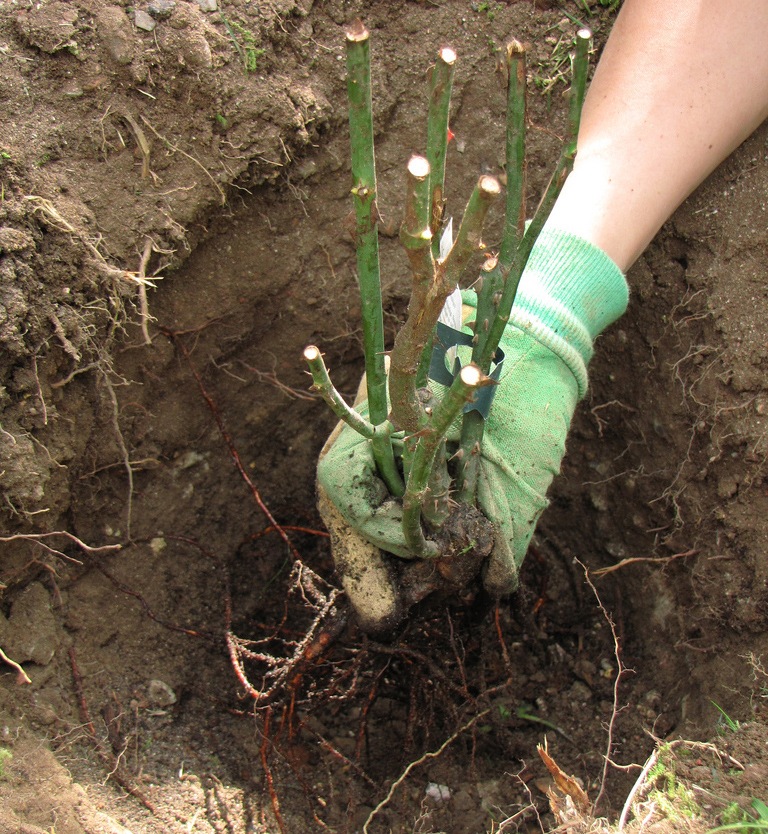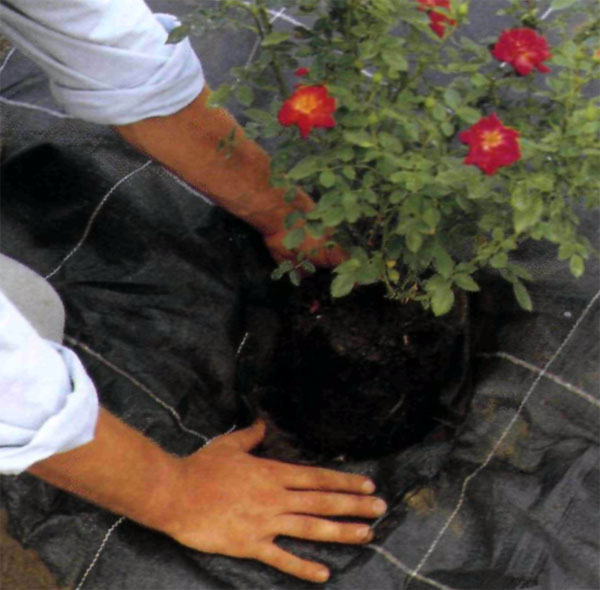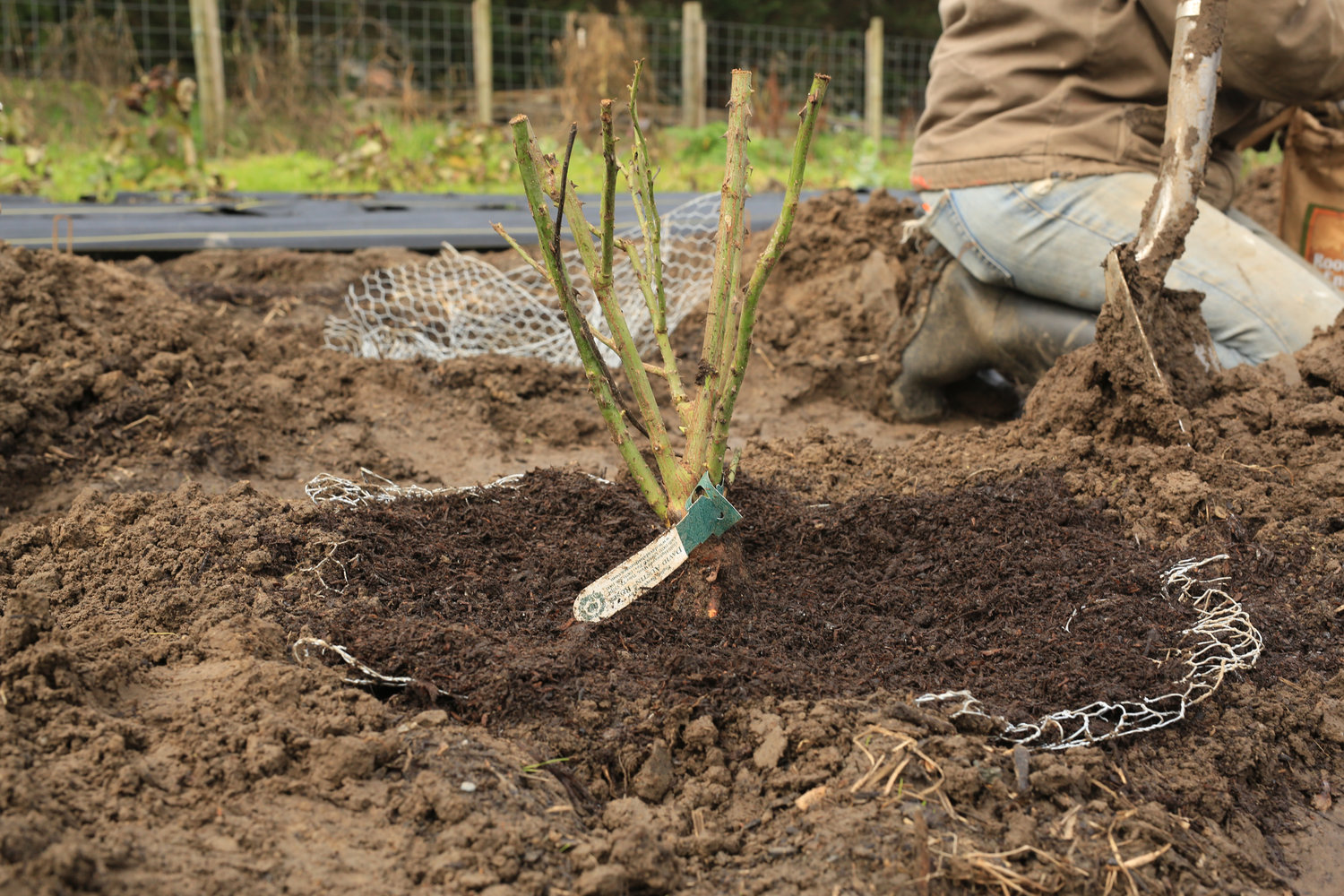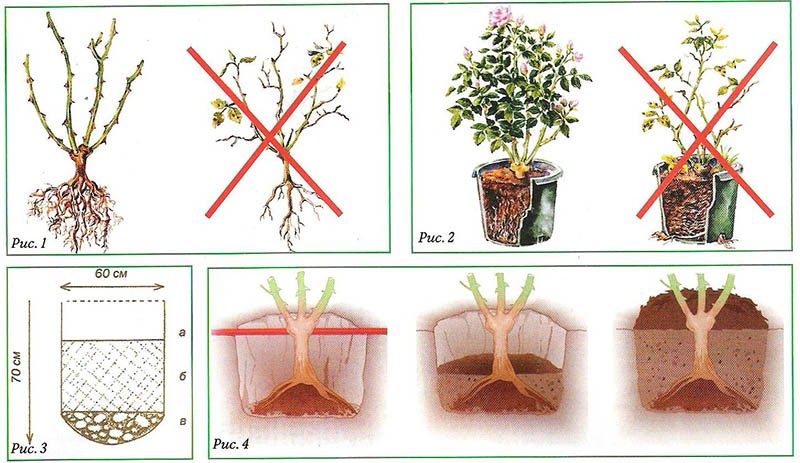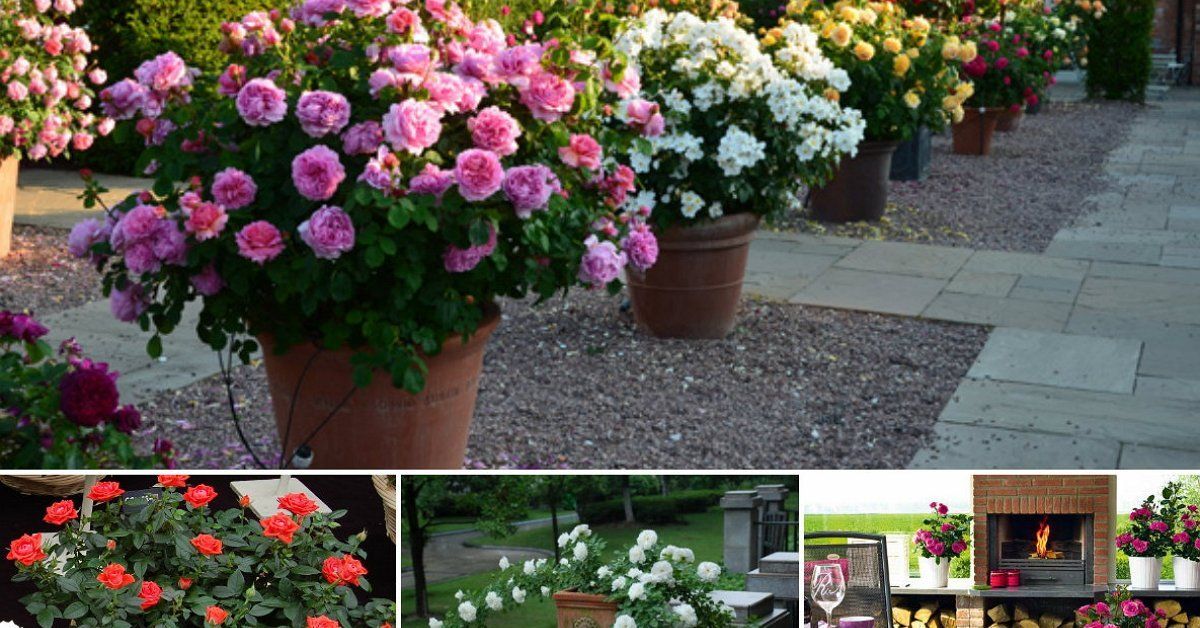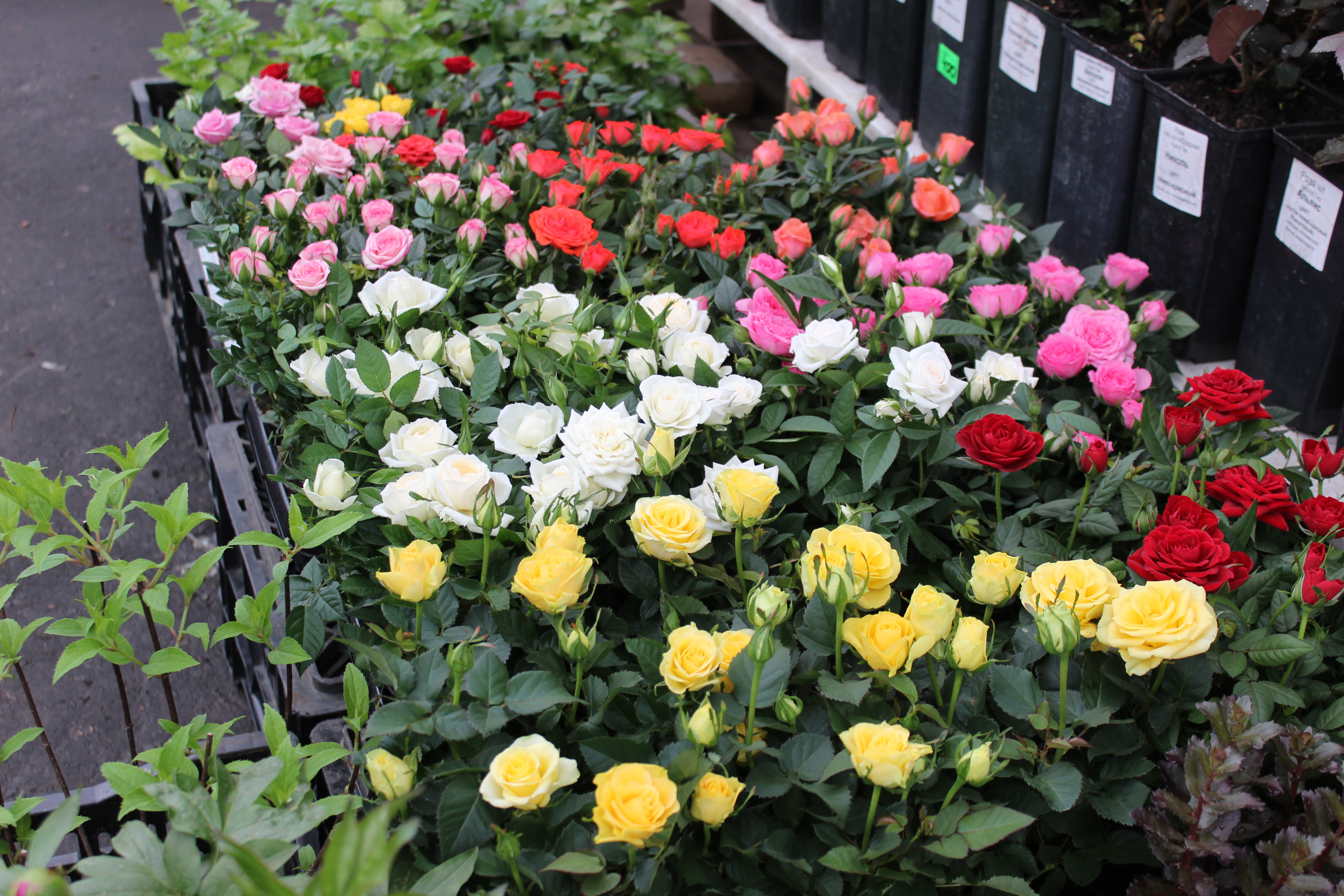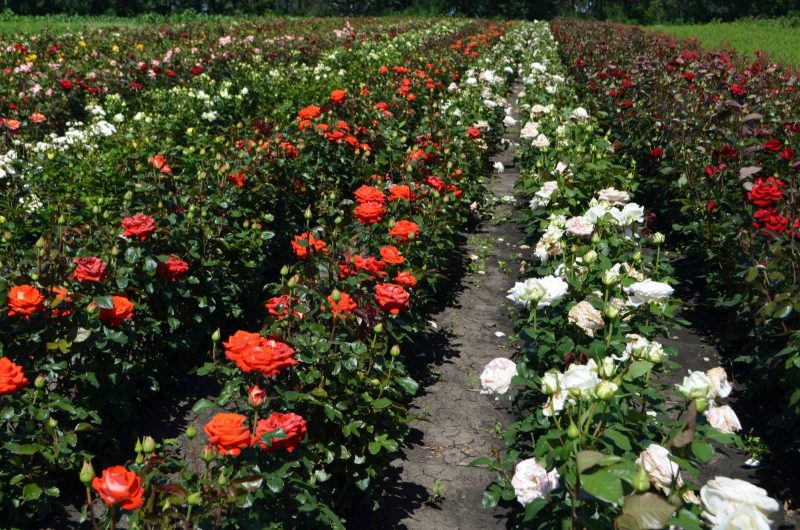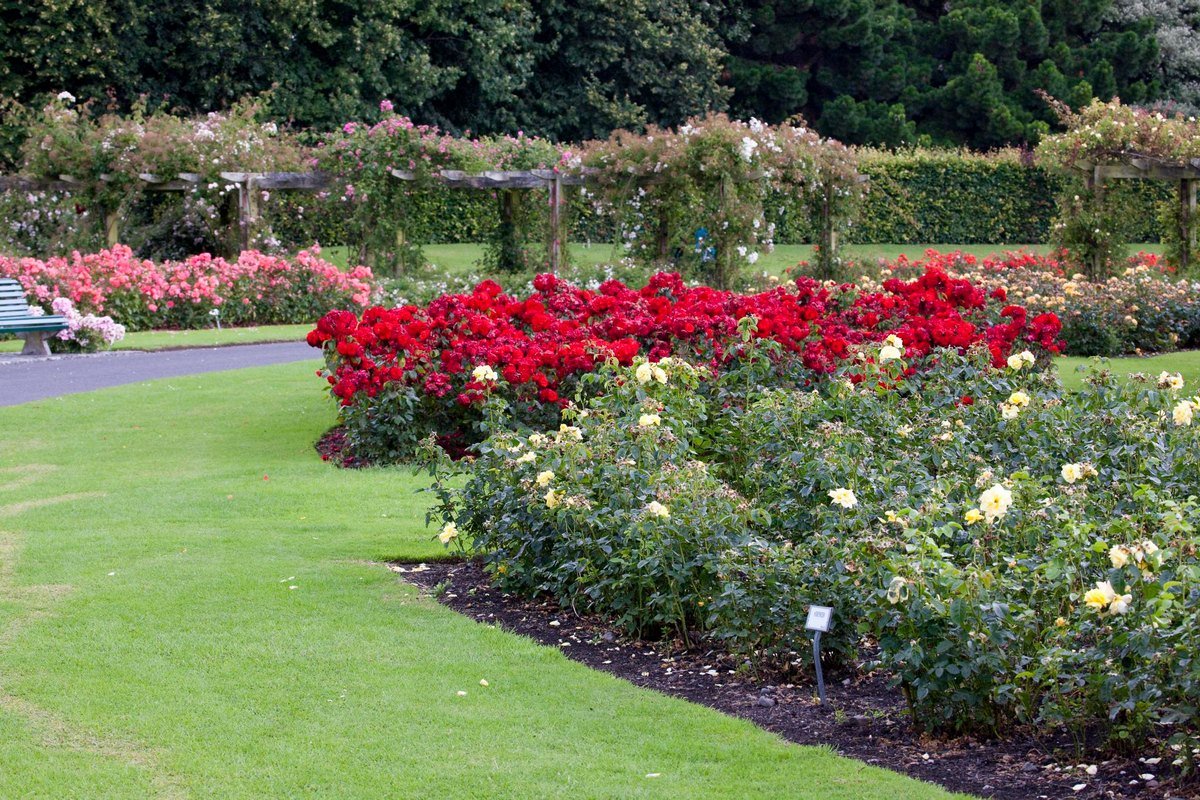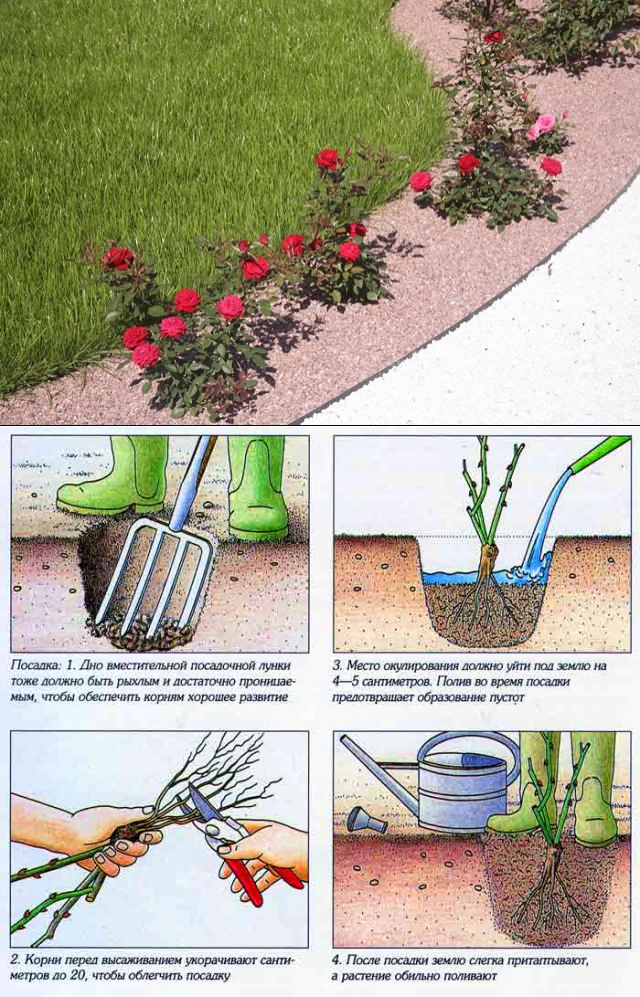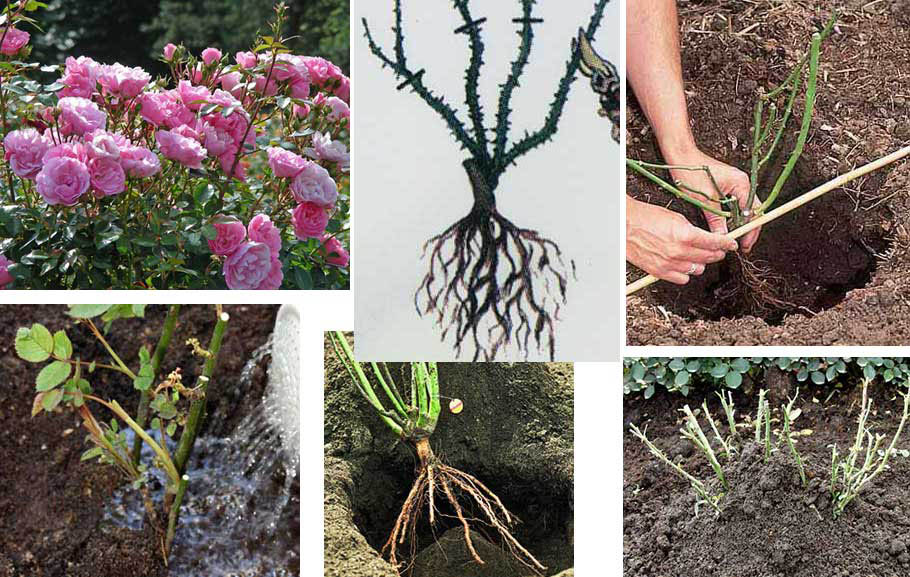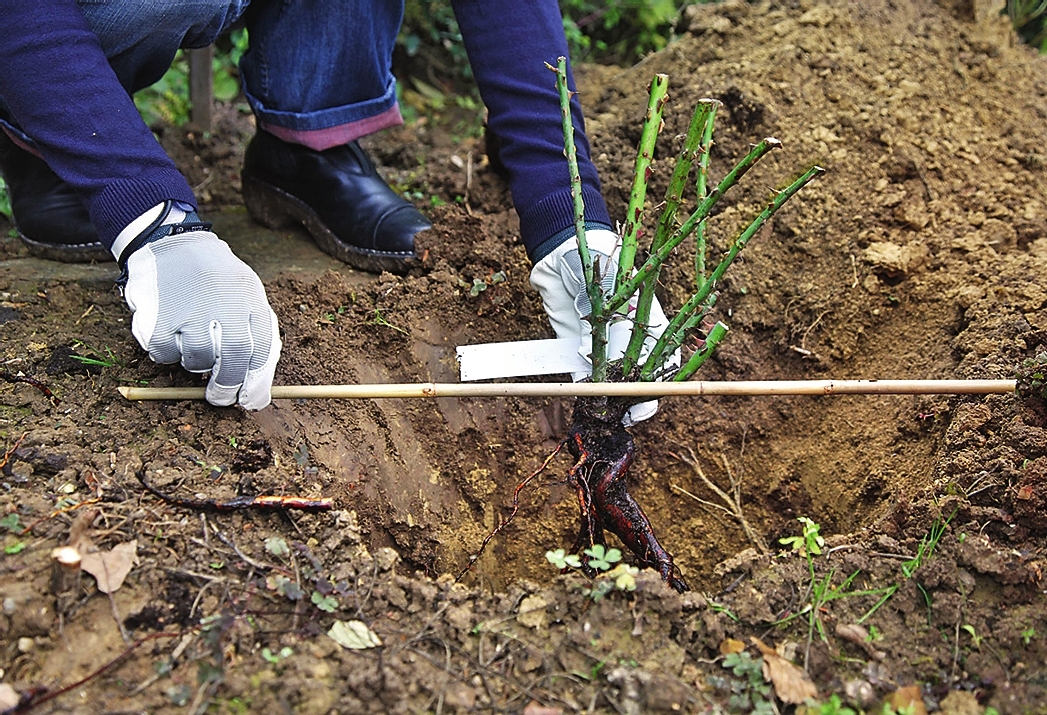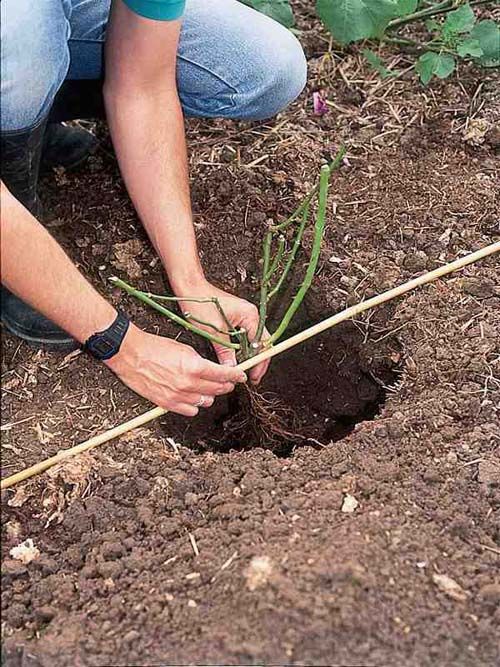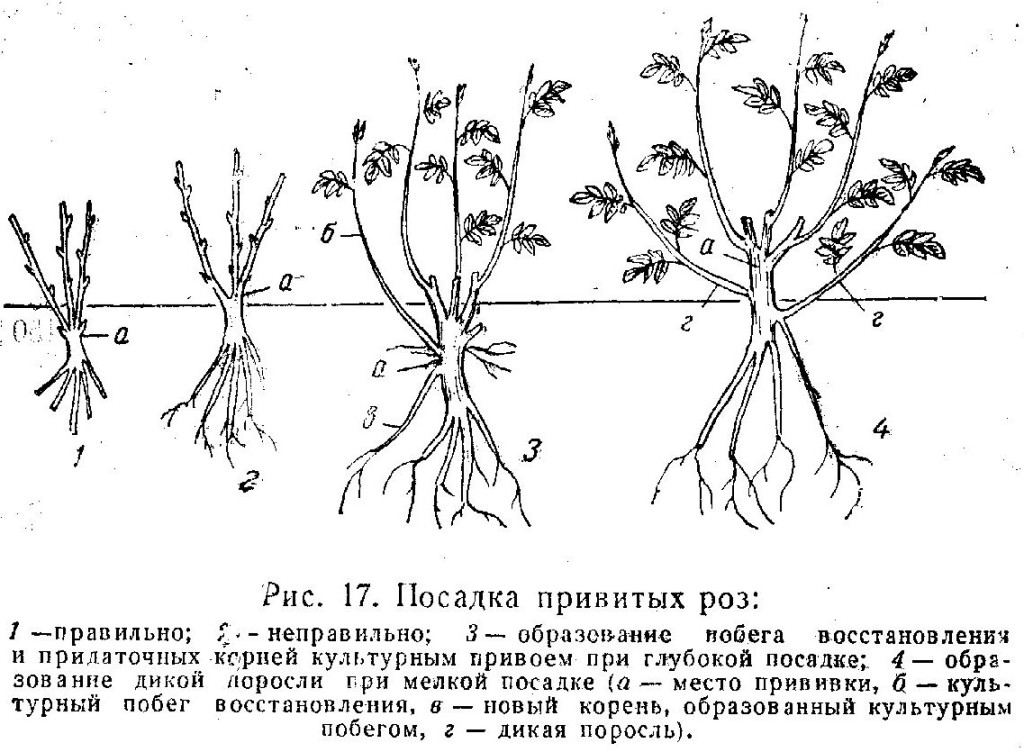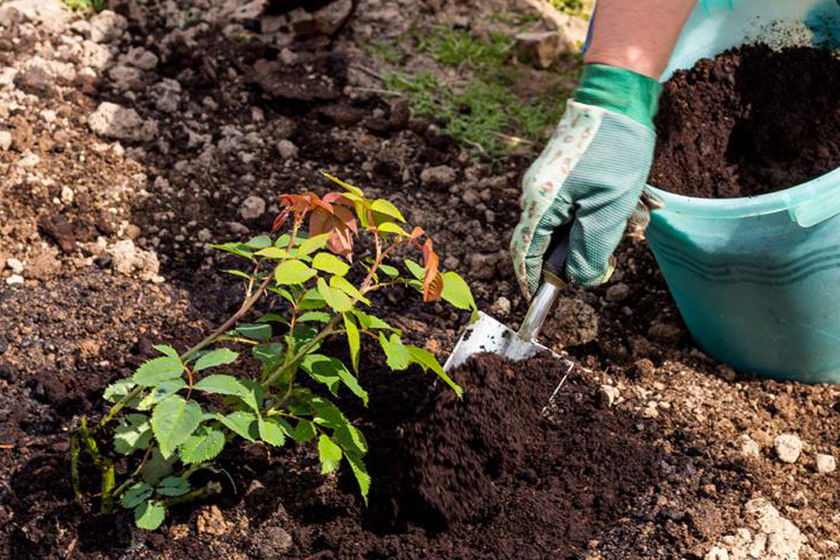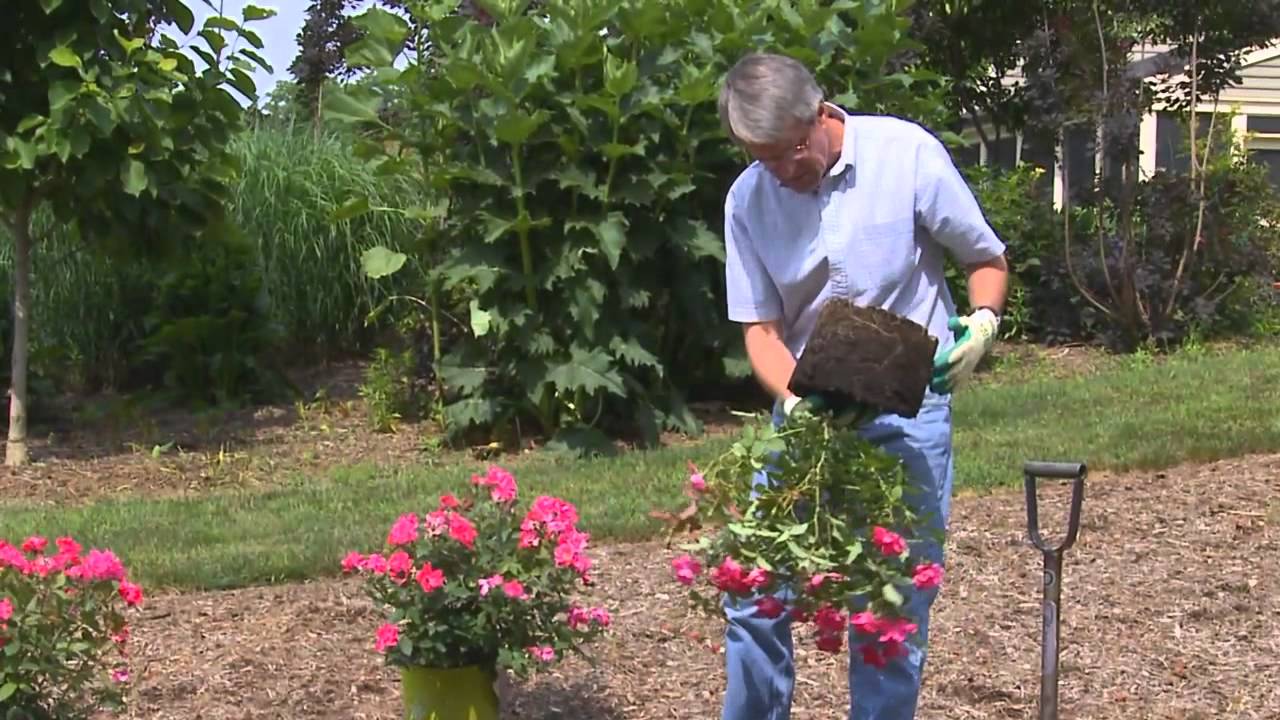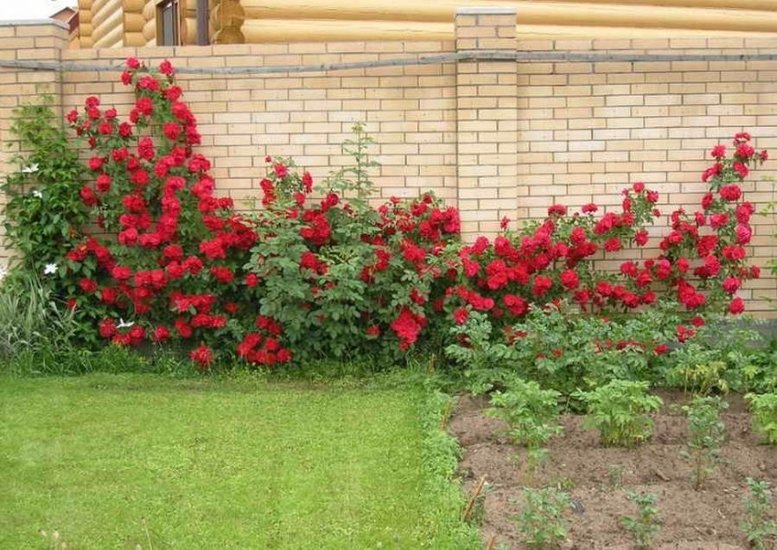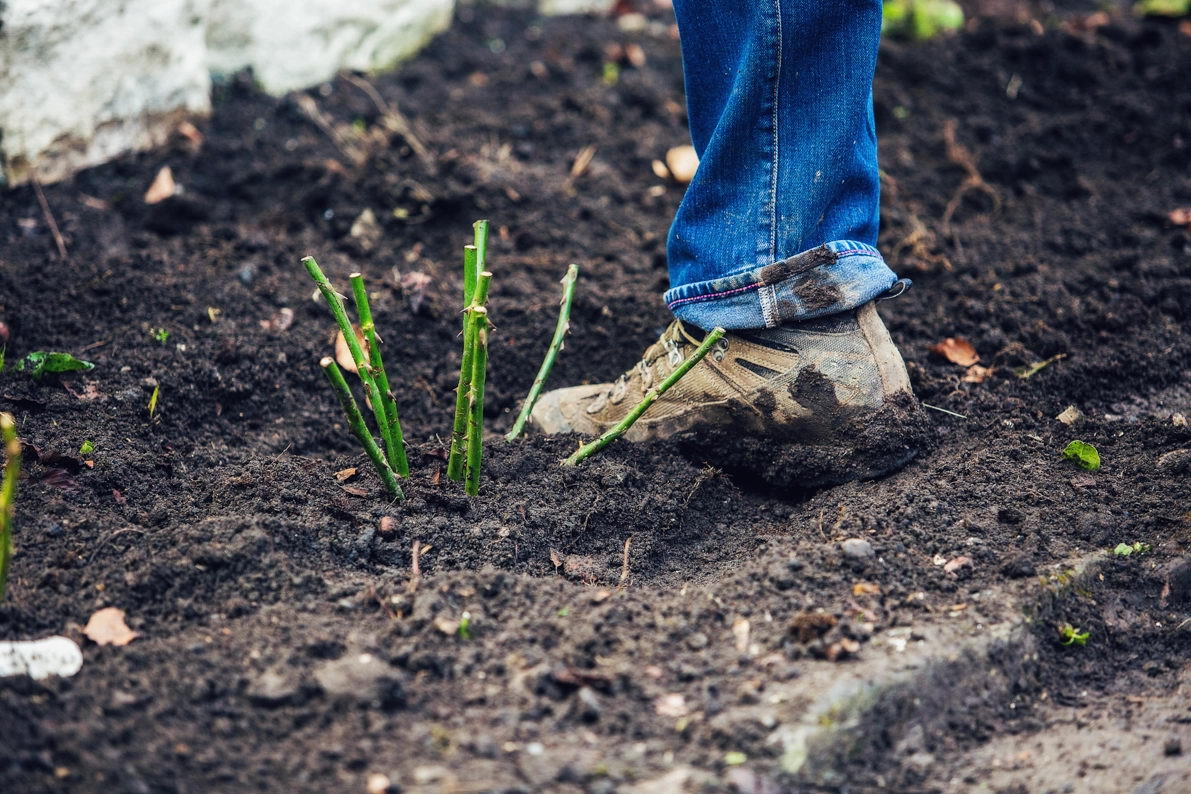Plant care
Even a beginner in gardening knows that growing roses requires adherence to certain rules for caring for them. Border roses are classified as unpretentious bushes, but they cannot be left completely unattended.
Watering rules and humidity
Watering low-growing curb roses should be frequent and regular, but not plentiful. The best time for irrigation is evening.
Important! Excessive or insufficient soil moisture must not be allowed. For the irrigation process, it is worth using water that has been settled in the sun.
In addition, the liquid must be poured under the root of the bush so as not to wet the aerial part of the rose, which is dangerous for it.
For the irrigation process, it is worth using water that has been set in the sun. In addition, the liquid must be poured under the root of the bush so as not to wet the aerial part of the rose, which is dangerous for it.
Top dressing and soil quality
Timely feeding is important for rose bushes.
In spring and autumn, compost is applied to the soil in such a way that about 5 kg of fertilizer per 1 m².
In addition, every 20 days, you can feed the curb shrubs with mineral fertilizers, herbal infusions or mullein.
Trimming and shaping
The pruning process is also an important part of caring for a rose curb.

You need to work with roses with a disinfected tool.
Damaged shoots are cut from the top between 2 - 3 leaves.
Important! Wild growth must be removed from grafted rose bushes. This should be done at the root collar to avoid the appearance of a new "wild"
At the beginning of growing a rose, the formation of the correct shrub shape should be ensured. To do this, pinch the shoots after 4 - 6 leaves, as well as remove the buds. In middle-aged bushes, the lateral stems are shortened.
Before wintering, the length of the overgrown branches is reduced and the buds that did not have time to form and bloom are cut off.
It is customary to transplant in early spring or autumn, because there is a possibility that the plant will not have time to take root. In this case, it is also worth pruning shoots up to 45 - 50 cm, the old stems are removed altogether.
Features of wintering a flower
Before preparing the plant for winter, it must be rid of old stems and foliage. The shelter is carried out at the risk of severe frosts, focusing on the resistance of a particular variety.
In the beginning, it is necessary to spud no more than 15 - 20 cm. After that, branches of coniferous trees, spruce or pine are laid out around the flower, and the shoots are pressed to the prepared surface. Then the shelter is covered with dry foliage.
Note! It is possible to prepare the shrub for the winter period by means of a frame made of film or roofing material. Shelter begins to be removed during the March thaw
They begin to remove the shelter during the March thaw.
Diseases, pests and ways to control them
The most common diseases of curb shrubs are:

Powdery mildew - the name of the disease is due to the similarity of stains with flour
- Black spot - the foliage of the bush is covered with spots of a black and brown hue, from which the use of fungicides and the removal of infected areas of the plant will save.
- Powdery mildew is a fungal disease that manifests itself as grayish spots of a powdery structure and against which fungicides are used.
- Rust is a disease in which brick-colored growths appear on the foliage and shoot. There is a rapid weakening of the leaves and their tarnishing. The plant is treated by spraying with Topaz, Bordeaux mixture or copper sulfate solution.

With a spider mite, the plant is quickly depleted.
Border roses can be attacked by the following pests:
- spider mite - the foliage becomes lighter, on the lower side the insect weaves a web, acaricides are used against such a pest;
- green rose aphid - green insects that feed on the sap of plant foliage and against which it is necessary to clean and spray with insecticides;
- rose leaf roll - a pest that eats bush leaves, you can defeat Aktara;
- rose leafhopper is an insect that eats the pulp of foliage and lays larvae in the inner part of the shoot; when this pest attacks, yellowing of the leaves is observed, their drying or falling off, Aktar is used.
Border roses are a great option for framing plantings. They are easy to grow both outdoors and in a pot. They are considered unpretentious plants, which nevertheless delight gardeners with their beauty during flowering, and this has earned the love of a considerable number of people.
How to grow shrubs
Caring for scrubs is not particularly difficult. It is enough to carry out all the measures necessary to maintain the health of the decorative culture and its abundant, long flowering:
- rose bushes prefer rather moist, but not waterlogged soil, therefore, the frequency of watering, depending on weather conditions, should be about one to two times a week;
- for irrigation measures, warm and settled water is used at the rate of ten to fifteen liters per one adult plant;
- ornamental culture should be watered early in the morning or in the evening, when the sun's rays are not able to cause burns on the aboveground part of the culture;
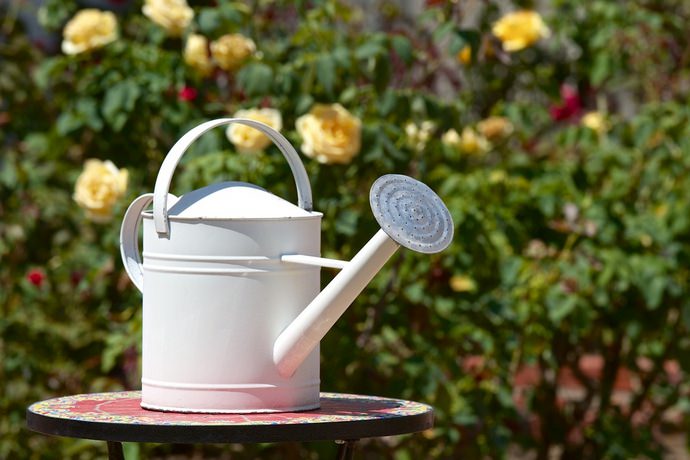
- after watering, shallow but thorough loosening of the soil is mandatory, which facilitates the flow of air to the root system of the rose bush;
- humus or high-quality compost is considered the best fertilizer, mulching with which helps to create favorable conditions for the growth and development of the rose and reduces the number of irrigation activities;
- mineral nitrogen-containing fertilizers are preferable in the spring, before the beginning of the active growing season and at the stage of bud formation;
- in the summer, it is recommended to give preference to phosphorus-potassium dressings, which stimulate flowering well.
How should you care for a flower garden?
Caring for a curb rose will not cause difficulties even for those who are engaged in its cultivation for the first time. If the basic requirements for pruning, watering, feeding are met, the plant will thank you with good growth and lush flowering.
Watering
Miniature roses need regular, but not abundant irrigation. Drying and waterlogging of the earth must not be allowed. Watering is best done in the evening using sun-warmed and settled water.
Top dressing
Growing roses is not complete without feeding. It is necessary to feed miniature plants several times. To do this, you must use fertilizers designed specifically for Rosaceae or other ornamental flowering plants. You can use organic matter: horse manure. It mixes with the soil and fits under the bushes. It is not necessary to use other manure, as the roots may burn.
Spring and autumn composting works well on miniature roses. It is laid out under the bushes at the rate of 5-6 kg per m2.
When the first buds form, the plant can be fed with calcium nitrate (1 tablespoon per bucket of water). This fertilizer has its own peculiarities of use:
- before feeding, the roses should be well watered so as not to burn them;
- after feeding - water again;
- the time of the procedure is in the morning or in the evening (when the heat subsides).
Additionally, every 15-20 days, you can feed it with mullein, mineral fertilizers or herbal infusions. Liming is necessary in September.
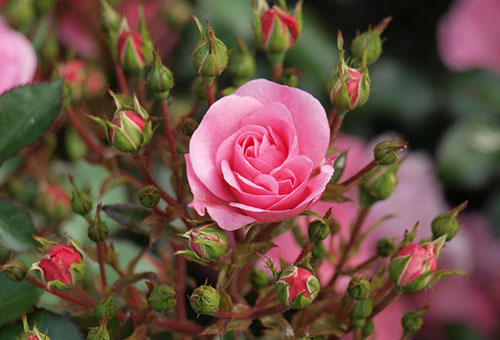
Leaving on hot days
Miniature roses do not tolerate rainy and very hot weather. It causes stress in them.During this period, reanimation agents will help to "cheer up" the plants: "Zircon", "Epin", "Ecosil", potassium humate.
It is important to protect the culture from overheating. The temperature rise above 25 ºC leads to overheating of the roots and deterioration of the condition of the roses.
Peat and hay laid under the bushes will help to cool them a little.
Pruning
Leaving includes another important point - competent pruning. It consists in removing damaged and dry shoots, in the formation of a beautiful and correct aerial part.
Pruning is done 5-8 mm higher from the healthy kidney. This procedure can be carried out all season. In the last pruning, extended new shoots and buds are shortened.
If the shoot is damaged, it is cut from above between 2-3 leaves
It is important to cut wild growth from grafted roses. Elimination of the "wild" above ground level will not give a result - it will grow again
Correct pruning is the removal of wild shoots from the very base (from the root collar).
In order for the bushes to grow proportionally, in the 1st year of their life, it is necessary to pinch all the shoots that appear after 4 and 5 leaves, remove the buds. In "old" bushes, the central shoots growing vertically are not trimmed, only the lateral ones are trimmed a little.
Preparing for winter
Despite the fact that many varieties of border roses can withstand frost, they need to be insulated for the winter. But first, all shoots and fallen leaves are removed. The first night frosts are a signal for the start of insulation. The sequence is as follows:
- to spud the plant, and the height of the embankment should not be less than 20 cm;
- put spruce or pine branches around;
- on them, gently pressing against the soil, lay the shoots;
- cover on top with dry leaves or spruce branches.
Many gardeners make a frame for insulating roses and cover it with a moisture-repellent material (roofing felt, insulating paper) folded in several layers. A plastic wrap is additionally laid on top. As soon as the thaw begins in spring, flowers can be opened slightly.

Care rules
The plant culture is undemanding to care. However, this does not negate the need to periodically water and feed. Otherwise, there is a risk of collision with some pathologies and pests.

Watering mode
It is necessary to water the roses, but at the same time the soil moisture level should be kept at a stable level. Do not allow the soil to dry out, as well as its waterlogging. The recommended watering rate is once every 2 weeks. In summer drought, the procedure can be carried out more often. Experienced gardeners advise to water the roses with running water heated in the sun. Therefore, the process is best done in the evening, when the settled liquid becomes warm.
Top dressing
Proper flower cultivation is not complete without stable and regular feeding. For the procedure, it is recommended to use special products suitable for the Rosaceae family. You can buy funds in specialized stores. Organic fertilizers are also used for feeding. For example, horse manure. It is mixed with damp earth and placed on the bottom of a dug hole. It is forbidden to use other manure, as it can burn the root system of the inflorescence.
In early spring, shortly before the growing season, you need to make mineral or organic fertilizing along the near-stem circle. When the first buds appear on the stems, the rose can be fed with calcium nitrate. This requires:
- Add a spoonful of mineral product to a bucket of water.
- Water the roses thoroughly with clean water so as not to burn them with fertilizer.
- Apply top dressing.
- Water the inflorescences again.
Mineral dressing is best done in the early morning. The interval between procedures should not exceed 20 days. In winter, you can feed the plant every 40 days. Before cold weather, liming is required.
Important! It is worth noting that during dry summers, fertilizers are recommended to be applied less frequently. If the summer is wet and cool, then feed the plant culture regularly.

Preventive actions
To prevent the development of seasonal diseases, preventive treatments are carried out in early spring. Funds for preparatory procedures are purchased in specialized stores. Preventive treatment is carried out in two ways: the leaves are sprayed to prevent the appearance of pests on them and a chemical product is introduced under the root of the plant to prevent the development of internal pathologies.
Pruning
Proper pruning is essential for the productive growth of the curb rose. It consists of removing dead branches, after which new shoots of the correct shape are formed. The procedure must be done with a sharp secateurs or a knife. With blunt tools, the branches of the rose may suffer. It is best if the blade is clean. This will help avoid fungal infection and decay.

Cut off shoots 5 mm higher from a healthy place. This can be done during the entire growing season. If the rotting process has started on the branch, it means that you need to completely remove the affected area so that the disease does not spread to the healthy part of the plant culture. If curb roses have been grafted, it is imperative to cut off wild growth from them. For proportional growth of shrubs, it is necessary to pinch young shoots.
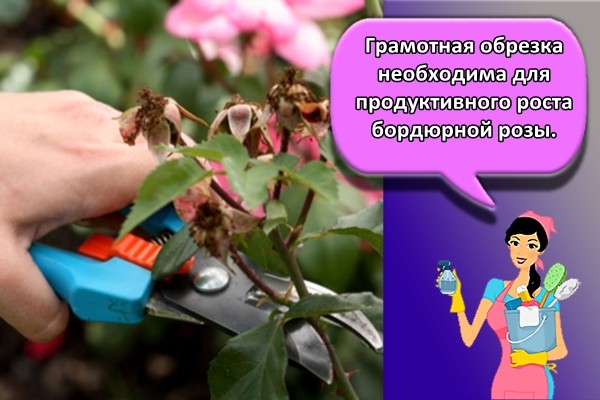
Preparing for winter
Despite the frost resistance, gardeners recommend insulating the inflorescences before the cold weather. Especially in the harsh climatic zones of the country. Before this, it is necessary to conduct a thorough examination of the bush, remove dried shoots and leaves from it. After that, carry out hilling with organic feeding.
To protect the plant from bad weather, some advise making special sheds made of moisture-resistant material. For example, you can make a frame based on roofing material, and then insulate it with plastic wrap. At the first warming, the structure can be disassembled so that the inflorescences can breathe. The frame can be opened slightly in winter on warm days, but not for long.
The best varieties
The group of miniature border roses includes varieties with a wide variety of shades of flowers and different abundance of flowering. Most of them belong to foreign selection, but they have proven themselves perfectly when grown in the soil and climatic conditions of our country. All varieties are adapted for cultivation in Russia and successfully combine a high level of decorativeness and absolute simplicity in care.
Variety name Botanical description Flower characteristic Advantages Disadvantages "Biedermeier" or "Biedermeier" Low and spreading shrub with dark green, shiny foliage. Plant height no more than 40-50 cm Large white flowers with pink edging of the petals. Light aroma. Resistance to powdery mildew and black spot, good winter hardiness. In wet weather, there is a tendency to rot buds "Lydia" or "Lydia" A small and relatively spreading shrub with dark green, shiny foliage. Plant height no more than 60 cm Small flowers with a diameter of 30-60 mm, collected 5-10 pieces per stem. Coloring of petals from delicate pink to creamy Ideal for group plantings and curbs, as well as cutting Needs to create a quality shelter for the winter Impala Cordana or Impala Kordana A low and relatively sprawling shrub with matte green foliage. Average plant height no more than 30-40 cm Cup-shaped buds of rich apricot color. The aroma is not pronounced Disease-resistant variety, suitable for cutting or growing in containers Needs to create a high-quality shelter for the winter period "Baby Masquerade" or "Baby Masquerade" Bush no more than 20-10 cm in height with a slight stiffness of the stems and small, glossy, dark green foliage Terry flowers, 3-5 cm in diameter, collected in a brush, change color from yellow to pinkish-red The variety tolerates winter frosts well, has increased resistance to the most common diseases For active and long flowering, it is necessary to adhere to the "Brilliant Sweet Dream" pruning technology or "Brilliant Sweet Dream" A short and relatively sprawling shrub with dark green, shiny foliage
The height of the plant is no more than 40-45 cm. Flowers are relatively small in size, collected in umbellate inflorescences, with golden-yellow petals and an orange frame. The variety tolerates winter frosts well, has increased resistance to excessive air humidity. "Or" Sugar Baby "The bush has lush green foliage, branches very well and can reach a width of 0.5 m. Very attractive, bright pink, double-type flowers with a diameter about 4.5-5.5 cm Resistance to powdery mildew and black spot, good winter hardiness For active and long flowering, it is important to adhere to the pruning technology White Bouquet or White Bouquet. The plant is quite wide, up to 0.75 m in diameter, with bright green, matte leaves
The height of an adult bush does not exceed 60 cm. The flowering is lush, with white or milky flowers. An unpretentious, abundantly flowering variety with high disease resistance and excellent winter hardiness. For active and long flowering, it is important to adhere to the pruning technology "Apricot Clementine" or "Apricot Clementine" With a wide crown, upright plant with dark green glossy leaves The height of an adult plant does not exceed 0.5 m Small-sized double-type in the process of flowering change color from tender salmon to peach color Disease-resistant and winter-hardy variety suitable for growing in containers Attention should be paid to the correct formation of the bush at all stages of vegetation
Reproduction of the English rose
The English rose can be propagated in exactly the same way as other varieties of this flower. For the English beauty, the propagation method is suitable by cuttings, layering and offspring, as well as grafting. Each of the above methods has a number of features that must be taken into account if you are going to independently breed English roses on your site. Experienced gardeners and rose lovers use grafting to propagate them, which is more efficient and productive.
English rose grafting
- For propagation of roses by grafting, cuttings or buds can be used, the latter are used much more often.
- First of all, it is necessary to grow a stock on which the English rose will subsequently be grafted. The original David Austin rose is only grafted onto the Rose Loxa rootstock, which is significantly different from the rootstock used in our territory. Russian gardeners use Rose canina for these purposes.
- It takes 2-3 years to grow a full-fledged stock. First, you need to collect the rosa canina seeds, place them in wet sand for several months for stratification.
- The seeds for the rootstock are sown in the middle of autumn to a depth of about 4 cm. In the spring, when the leaves appear, you can pinch the root of the seedlings and dive them.
- For grafting, seedlings are selected, the thickness of the root collar of which is at least 7 mm.
- Further, on an adult English rose bush, it is necessary to select healthy and mature shoots with buds.
- After cutting, remove all leaves, leaving only the petiole with buds.
- On the grown rootstock, clean the root collar from the ground and wipe it with a rag. Next, you need to make an incision in the form of the letter T. The vertical incision line should be 2.5 cm deep, and the horizontal one 1 cm.On the rootstock shoot, you need to cut off the bud with a piece of wood about 2 cm long.
- After that, carefully holding the scion by the shield, insert it into the cut made from bottom to top. The protruding part of the flap must be cut off.
- The vaccination must be well wrapped with a special film. The results will appear in 2 weeks.
Propagation of an English rose by offspring
Park roses, which include the English rose, can be propagated by root shoots, which appear in large numbers during the season. You should not rush to transplant such offspring, since the root system is very weak at first.However, after about a year, they will be strong enough to withstand the process of separation from the mother bush. It is best to carry out the branch in early spring, when the snow melts.
Propagation of an English rose by cuttings
It is also a very popular breeding method for the English rose.
For planting material, cuttings are harvested from well-ripened shoots of the current year. It is necessary to cut cuttings about 15-20 cm long, the main thing is that they have 3 leaves on them.
After preparing the cuttings, it is necessary to cut off 2 leaves from them on the sides, leaving only one at the top.
On your site, pick up a place hidden from the sun, quite calm. Dig it up thoroughly and remove weeds, loosen and level.
Plant the prepared cuttings about 15-20 cm apart. At the same time, they must be buried in such a way that only a leaf remains on the surface.
After planting, be sure to cover each stalk with an open-necked plastic bottle.
When the cold begins, the cuttings must be carefully covered and covered with snow.
Already in the spring you can see the first leaves on your cuttings, however, it is recommended to transplant English rose cuttings to a permanent place only after a year.
In this case, it is important to dig them out together with a clod of earth so as not to expose the root system.
Propagation of an English rose by layering
This breeding method is considered the easiest.
It is important for him that on the rose bush there are sufficiently long and flexible shoots located close to the ground.
Pick out a fairly long and strong branch on the English rose bush and bend it to the ground. Next, make a small incision on the bottom side and secure the layering well so that it does not rise.
After that, sprinkle it with soil, leaving only the top.
During the entire rooting period, it is important to water and remove weeds.
After about a year in the spring, you can safely detach a young English rose seedling from the mother bush and transplant it to a permanent place.
Apricot Clementine
The Epricot Clementine variety was bred relatively recently - in 2001. Its medium-sized double buds (4-6 cm in diameter) in the process of flowering change their shade from pale salmon to peach. Roses of this variety retain their color in the bright sun, and also tolerate partial shade well. 4-5 flowers grow on the stem. A wide, upright bush with dark green shiny leaves reaches a height of 50 cm.
This miniature rose blooms profusely from early summer until frost. Epricot Clementin can be grown both in containers and in soil. The variety is resistant to powdery mildew and black spot and practically does not get sick even in unfavorable years. It tolerates frost well: with sufficient snow cover, it is not necessary to cover the rose for the winter.
| Appointment | Plant height | Bloom | Scent | Winter hardiness |
| 30-50 cm |
Abundant, continuous (June to September) |
Weak, almost nonexistent | High |
As you can see, roses are not such capricious beauties as people usually think of them. Any of the ones presented in our review will survive the winter with dignity and frame your garden with a luxurious border.
Examples in landscape design
Border mini-roses fit perfectly into the landscape design of any personal plot. Due to their compactness, bright colors and sophistication, they are perfectly combined with various garden plants. These colors can be used to decorate borders of various shapes and designs. Compositions of rose bushes planted near stairs, paths, recreation areas and "dry streams" look beautiful. To get an interesting effect, roses should be combined with other vibrant flowers and herbaceous perennials. Combinations of roses with dwarf barberries, Japanese spirea and lingonberry bushes will help to emphasize the beauty of flowers.


When decorating a site, it is important to consider that red roses should not be placed next to orange, purple and pink flowers. If a flower border is installed along a garden path, it can be filled with combinations of white with blue, red with lilac, yellow with purple.
It is best to use flowers of the same variety for design. Such compositions can be made horizontal, or they can be placed in flower beds lined with natural stone. In the spring, planting snowdrops, hulls and muscari will help dilute the juicy colors.
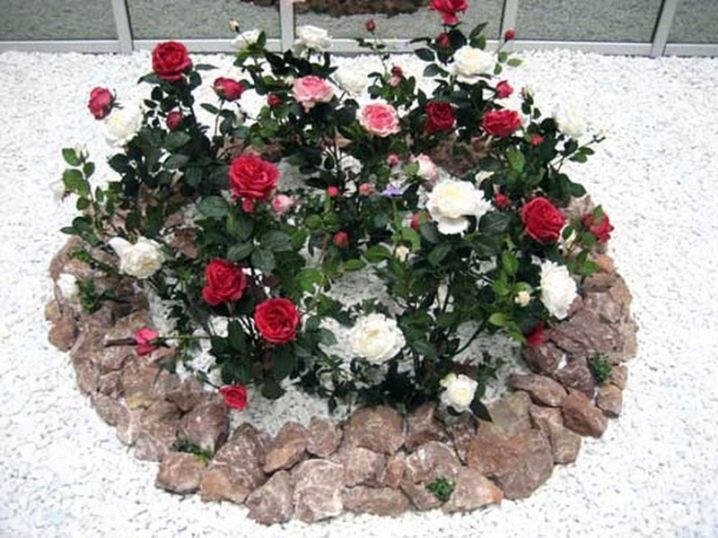
If a lot of shrubs are planted on the personal plot, they can be supplemented with flower beds of roses. They will look win-win against the background of spruce, thuja, cotoneaster and magnolia. To avoid clumsy design, bushes and plants should be placed at a distance of 1 meter. The courtyard fences look great, near which are planted rose bushes and lilacs, chubushnik, yellow acacia. This combination of the palette gives the site an unusual look.
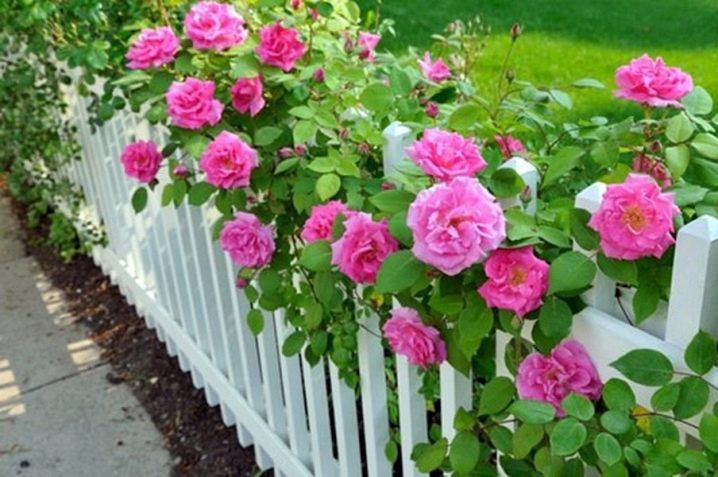
For information on how to plant border roses, see the next video.
Further care
Curb roses require simple maintenance. It consists of the following activities:
- regular irrigation;
- top dressing;
- weeding;
- pruning;
- shelter for the winter.
Also, flowers are treated with special means from harmful beetles, diseases.
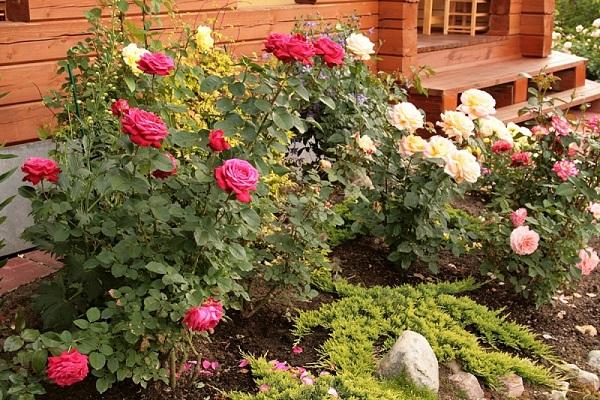
Soil replenishment
Border roses should be fed with the following compositions:
- organic matter is horse manure, it is mixed with the ground, laid under the bush;
- in spring and autumn, compost is applied, laying out under the bushes at the rate of 5 kilograms per m2;
- when the first kidneys form, feed 1 tbsp with calcium nitrate. on a bucket of water.
Before adding the nutrient composition, the roses must be watered abundantly so that they do not burn. After pouring water again. Perform the manipulation early in the morning or in the evening.

Watering
Watering rose bushes should be done early in the morning or in the evening. The irrigation frequency will be approximately 2 times a week. It all depends on soil moisture, weather conditions. The water should not be icy, it is advisable to stand it up to air temperature. With excessive moisture, the plant can rot. It is also impossible to overdry it, otherwise, the roses will fade.
Hot weather care
In extreme heat, you should irrigate the leaves with settled water. Carry out the procedure in the evening when the sun hides. Due to the action of high temperature, the rose grows dull, wilting. It should be additionally fed with Zircon, potassium humate or Ecosil.

Pruning
Competent circumcision consists in excision of damaged and dry branches, the formation of bushes.
- To avoid decay, disease attack, use only clean, disinfected pruning shears.
- Trim the shrub 5-8 millimeters higher from the healthy bud.
- The event is held all summer.
- For the last time, shorten the extended new shoots and buds.
- If the branches are damaged, cut them between 2-3 leaves.
- It is necessary to remove wild growth from roses. The elimination of the "wild" above the soil level will not give an effect - it will grow again. Excision of wild branches from the very base.
- In order for the bushes to grow proportionally, every year, pinch all the shoots that have formed after 4 and 5 leaves, remove the buds.
In old shrubs, the central, upright branches are not pruned. Only the side ones are cut a little.
Treatment for diseases and insects
Miniature flowers need regular inspection, this will help protect them from the attack of bacteria, harmful beetles. If infection has been noticed, immediately treat with insecticides. You can buy them at nurseries. To prevent diseases, the rose is fertilized with organic matter and mineral dressings.

How to shelter them for the winter?
For the winter, roses should be insulated, first remove all fallen leaves and shoots. The procedure is done in this way:
- huddle the plant, the height of the embankment should be at least 20 centimeters;
- lay branches or needles around;
- put shoots tightly on them;
- the last layer is dry foliage or spruce branches.
You can also make a protective frame from cling film and roofing material.
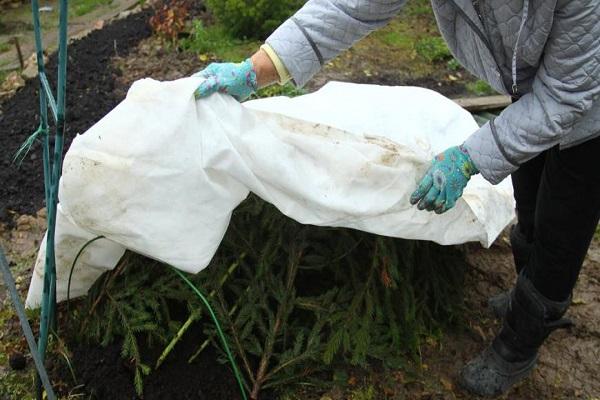
Landing at their summer cottage
When to plant curb roses
It is recommended to plant seedlings in spring, so that young plants can form a strong root system before the arrival of autumn and winter and are ready for severe cold and severe frosts. The most favorable time is mid-spring or the second half of April. The soil should warm up well by this time, and the threat of night frosts has already passed.
Choosing the perfect location
Choosing a suitable site for planting curb roses is not an easy task. Even in the summer season, they prefer to be at a temperature of + 19 ... + 22 ° С. An ideal place would be such a place where the sun would shine brightly only before 11 and after 17 hours, and the rest of the time, shadow or penumbra conditions remained on the site. At the same time, flowering crops should not be exposed to strong gusts of wind and constant drafts, from which the soil dries out, and the flowers lack moisture.
Another important condition when choosing a place is to take into account predecessors. These cannot be plants from the Rosaceae family, as they negatively affect the next planting and can leave a "legacy" of pests and spreading diseases.
What kind of soil is needed
For the full development of curb roses, high-quality soil with moderate moisture is needed, without stagnant water and not in the lowlands, light in structure and with good water and air permeability.
Landing scheme and features
The size of the planting hole depends on the volume of the root part of the seedling - the hole should be slightly larger. It is recommended to pour a drainage layer about 5 cm thick at the bottom, and then on 1/3 of the nutrient substrate intended for representatives of Rosaceae. The bush is placed in the center of the hole and each root is carefully straightened. It is necessary to fill the hole to the brim so that the root collar remains 2 cm below the soil surface. It is recommended to lightly compact the soil around the seedling and moisten it abundantly. After the water has been absorbed, a 2-3 cm layer of peat mulch can be applied around each plant.

When planting several bushes, an interval between them of about 30-40 cm should be observed.
Diseases and pests
Any plants, including the curb rose, can be attacked by insects and get sick.
Neighborhood with many species of plants can prevent the appearance of insect pests. If roses are planted next to marigolds, sage or onions, they will never have caterpillars, aphids, sawflies, spider mites.
In order to prevent and with a single lesion, rose bushes can be sprayed with infusions of onions, yarrow, garlic, calendula, and sprinkle the ground around them with ash. If pests nevertheless appeared en masse, you should not immediately run for chemicals. Try natural, less harsh remedies first.
Dissolve laundry soap in 10 liters of hot water and add a few branches of wormwood, mix, boil for 15 minutes. After the solution has cooled, mix everything again, strain and spray the bushes.
If after treatment the pests have not died, re-spraying can be repeated after 5-7 days.
When natural remedies fail and insects are spreading, insecticides can be used:
- against spider mites - "Sunmight";
- against aphids, caterpillars and sawfly - "Mospilan", BI-58, "Aktofit", "Aktara".
Miniature roses are highly susceptible to diseases:
- powdery mildew;
- black spot;
- rust;
- alteriosis.
It is easy to prevent their appearance. It is enough to spray the culture with solutions of copper sulfate (3%), DNOC (1-3%) or nitrophenol (2%) before sheltering the culture for the winter and after opening.
If an infection has occurred, then the following means are used in the treatment.
- Water-soluble sulfur (1%), Bordeaux mixture (1%) are effective against powdery mildew.
- Copper oxychloride (0.2%), Bordeaux (1%) mixture will help get rid of black spot.
- Rust can be cured with water-soluble sulfur (1%) and copper oxychloride (0.2%).
- Spraying with foundation (0.2%) or copper oxychloride (0.4%) will help to cure an infectious leaf burn.
Some fungal diseases (for example, powdery mildew) appear if the care and planting conditions have been violated: bushes are planted close to each other, abundant watering.
When caring for a plant, it is important to regularly inspect each one, pick off "suspicious" leaves and burn them, cut off dry branches in a timely manner so that diseases or pests from one infected plant do not pass to neighboring ones.


